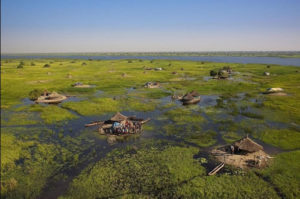South Sudan, while still an emerging tourist destination, offers a unique blend of natural beauty, diverse wildlife, and rich cultural experiences for adventurous travelers. Here are some of the top attractions:
Wildlife and Nature:
- Boma National Park: This is one of the largest national parks in Africa and is famous for hosting the world's second-largest animal migration, primarily involving white-eared kob and tiang antelope. It's also home to elephants, giraffes, lions, cheetahs, and other diverse wildlife. The migration typically occurs between March-April and November-January.
- Bandingilo National Park: Located near the White Nile, this park also plays a crucial role in the annual wildlife migration. It's home to giraffes, lions, buffalos, cheetahs, leopards, gazelles, and elephants.
- Nimule National Park: Situated near the Ugandan border, Nimule is the most accessible national park. It's known for elephants, hippopotamuses, warthogs, crocodiles, and various antelope species. The Fulla Rapids within the park are popular for water rafting.
- The Sudd: This vast wetland, formed by the White Nile, is one of the world's largest swamps. It's a unique ecosystem and a haven for birdwatchers, with over 450 species, including black-crowned cranes, giant white pelicans, and shoebill storks. Exploring the Sudd by canoe offers a chance to witness this natural wonder up close.
- White Nile River: The world's longest river flows through South Sudan, offering opportunities for boat cruises, fishing, and sunset trips to historic islands.
Cultural Experiences:
- Juba: As the capital city, Juba is a bustling hub. Key attractions include:
- Konyo Konyo Market: A vibrant local market where you can find traditional crafts, textiles, and local produce. The cattle market is also a mesmerizing sight.
- John Garang Mausoleum: A significant historical site dedicated to the former leader who played a crucial role in South Sudan's independence.
- Nyakuron Cultural Center: Built to showcase the diverse culture of South Sudan, it hosts dance, singing, and storytelling performances.
- Jebel Kujur: A small mountain offering panoramic views of Juba.
- Mundari and Dinka Tribal Villages: South Sudan is home to many indigenous ethnic groups with unique cultures. Visiting a Mundari or Dinka cattle camp provides an incredible opportunity to witness their traditional way of life, their deep connection with their Ankole-Watusi cattle, and distinctive practices like facial scarring.
- Wrestling in Bor: Wrestling is a highly popular sport in South Sudan, particularly in Bor, where tournaments are often organized.
- Local Markets: Beyond Juba, other towns like Kapoeta offer markets known for unique crafts, such as handmade beadwork.
Other Notable Sites:
- Mount Kinyeti and the Imatong Mountains: South Sudan's highest peak (at 3,187m) offers challenging hikes and the chance to experience pristine wilderness and spot wildlife like leopards, buffalos, and elephants.
- Wau: South Sudan's second city, known for its colonial-era buildings, including the large 1913 cathedral, and a mix of tribes that give it a cosmopolitan feel. The Wau Zoo is also home to striped hyenas.
Important Considerations for Travelers:
South Sudan is still developing its tourism infrastructure and has faced periods of conflict. It's highly recommended to:
- Plan carefully: Obtain necessary permits and stay informed about current travel advisories.
- Hire a local guide or join an organized tour: This is often the best and safest way to explore the country.
- Travel during the dry season (November to April): This period offers the most favorable conditions for wildlife viewing and access to remote areas.



0 Comments
Hi, How are you dear. Hope you are good